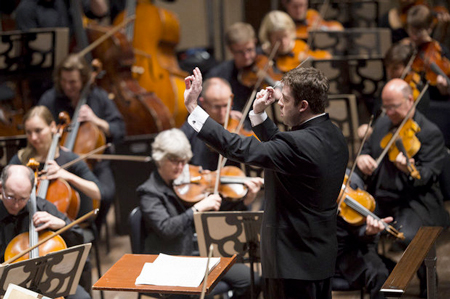by Daniel Hathaway

Thomas writes in her notes: “The work’s descriptive title, ‘Juggler in Paradise’ is a poetic image for the way solo and orchestra relate, a continuous rhapsodic cadenza set against colorful ‘paradisiacal constellations.’” A lot of those astral colors come from a vast toy chest of percussion instruments that keeps six players busy during the Concerto’s twenty-minute duration.
Playing seated from a platform, Preucil began the proceedings with a dignified solo soon to be punctuated by percussion, harp, and flute licks. Unexpected events soon begin cropping up, intensified by a trumpet call and brass fanfares, and topped off by a bongo drum cadenza (Marc Damoulakis).
A slow section sends a message of foreboding, sweetened by solo violin and horn (Jesse McCormick) and complicated by colorful clusters and a trumpet solo. The denouement leads back to something resembling the texture of the beginning.
Thomas has a fine ear for color and impressive skill in orchestration. Preucil, Mitchell, and the Orchestra put this eminently listenable piece across with all the nuanced care it deserves.
While the piece is famous for incorporating the Fanfare for the Common Man into its final movement, Copland’s Third Symphony also celebrates the percussion section. Mitchell let the first movement unfold with a gentle sense of purpose and spaciousness. He took a laid-back approach to the second-movement scherzo, and with the help of bassoonist John Clouser and oboist Frank Rosenwein, sculpted an understated lament in the third.
Wind solos intertwine at the beginning of the finale, paving the way for its startling outburst of brass and percussion — if you know the piece, you know what’s coming, but you willfully forget for the thrill of being surprised once again. After subsiding into a frolicking episode, the fanfare forms again like a gathering storm and the Symphony ends with glorious sonorities — loud, to be sure, but welcomely so. One climax was visually heightened by two percussionists vigorously twirling wooden ratchets.
Underlining the Americana theme of the evening, the Fridays@7 concert was followed by bluegrass in one of the Severance Hall lobbies — perhaps an ironic nod to Copland, the big city-born lad who came to symbolize the aspirations of a whole nation with his patriotic works during World War II.
Photo by Roger Mastroianni from an earlier performance.
Published on ClevelandClassical.com March 7, 2017.
Click here for a printable copy of this article



